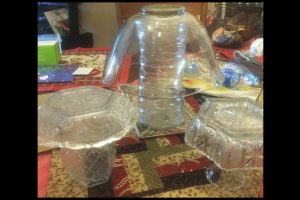What is a fairy garden? In folklore, tales from near and far tell of fairies living in miniature underground environments. In many countries, ranging from Great Britain, Scotland, and Ireland, to Finland, Iceland, France and beyond, stories abound of the little people, fairies, gnomes, leprechauns and a host of others. There’s Tinker Belle, the tooth fairy, Cinderella’s fairy godmother. I could go on and on.
The tales of these fairies describe places of refuge for these imaginary magical inhabitants to get away from their underground world. If you wish to create a fairy garden to entice these magical beings into your world, how would you go about it? It’s different for everyone. Your garden can be as whimsical, as elaborate or simple as you would like. It can be as big or small as you want.
Try creating a miniature cultivated space in a small container in your home. Or select and set aside a space in a cultivated garden setting for a place where a gnome or fairy might want to live. It might even be on the edge of the forest next to a tree either growing or fallen.
Settings for fairy gardens include pottery containers, wine barrels or a section of your flower or vegetable garden. You can add to or transform a parkway median.
When it comes to furnishing your fairy garden, anything from nature would be good to add to their garden decor. Small twigs can be fashioned into a fence or ladder or a piece of furniture such as a table, chair or bed. They may like things that shine—like buttons and marbles. A scrap of fabric can be a blanket or rug.
Your garden’s location and size will dictate how elaborate or simple you want to make it. In a small container, a tiny rock path might lead to a violet plant with a twig fence around the pot’s edge. In a flower bed with a rose tree, a rock “wall” could circle the base of the plant with a small ladder leaning against the stem.
Whether your fairy garden is indoors or out will affect the size and type of plants you choose. Indoor containers may hold small succulent plants; outside, work with the ones you already have in your garden. Or go to a tree at the edge of your property and make a home for gnomes or fairies there.
No matter how young or old you are—from toddler to wispy grey locks—you can still enjoy the whimsy of a small magical garden created exactly the way you want. For a toddler, you could use a mason jar with potting soil, one plant, one rock and a pipe cleaner twisted into any shape. In my containers, I fashioned glass mushrooms by gluing a vase and candy bowl to create a refuge for my fairy from the rain. She sits on a rock next to a patch of moss on a twig near a purple violet. Of course, I’ve not seen her there but I know she would like it.
My imaginary group of fairies is sometimes referred to as a “finagle.” However, not all scholars believe that fairies were imaginary. It is possible that their myth represents the suppression of multiple Celtic or Germanic deities by monotheistic religions. And, the small size of fairies could refer to smaller prehistoric stone age humans whose bones have been found throughout the world. Regardless, legend says that fairies possess powers that bring health, happiness and blessings. Don’t all gardens do this?
Diane Miller is a University of California Cooperative Extension Master Gardener of Tuolumne County.

